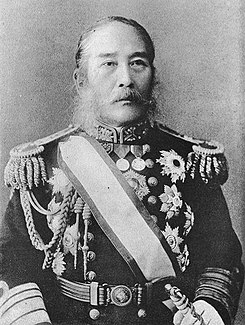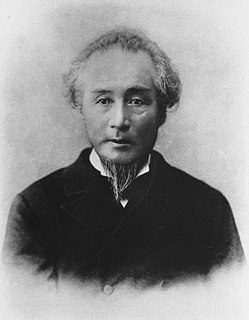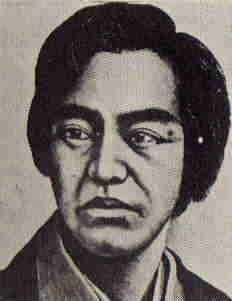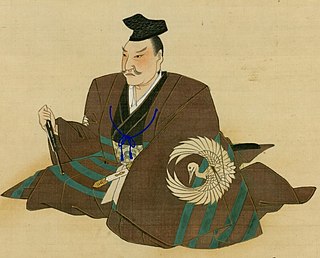 W
WA hatamoto was a samurai in the direct service of the Tokugawa shogunate of feudal Japan. While all three of the shogunates in Japanese history had official retainers, in the two preceding ones, they were referred to as gokenin. However, in the Edo period, hatamoto were the upper vassals of the Tokugawa house, and the gokenin were the lower vassals. There was no precise difference between the two in terms of income level, but hatamoto had the right to an audience with the shōgun, whereas gokenin did not. The word hatamoto literally means "origin of the flag", with the sense of 'around the flag', it is described in Japanese as 'those who guard the flag' and is often translated into English as "bannerman". Another term for the Edo-era hatamoto was jikisan hatamoto (直参旗本), sometimes rendered as "direct shogunal hatamoto", which serves to illustrate the difference between them and the preceding generation of hatamoto who served various lords.
 W
WAbe Masatō was the 7th Abe daimyō of Shirakawa Domain, and an important official in the Bakumatsu period Tokugawa shogunate.
 W
WWilliam Adams, known in Japanese as Miura Anjin , was an English navigator who, in 1600, was the first Englishman to reach Japan during a five-ship expedition for a private Dutch fleet. Of the few survivors of the only ship that reached Japan, Adams and his second mate Jan Joosten were not allowed to leave the country while Jacob Quaeckernaeck and Melchior van Santvoort were to go back to the Dutch Republic to invite them to trade. Adams and Joosten settled in Japan and became two of the first ever Western samurai.
 W
WArai Hakuseki was a Confucianist, scholar-bureaucrat, academic, administrator, writer and politician in Japan during the middle of the Edo period, who advised the shōgun Tokugawa Ienobu. His personal name was Kinmi or Kimiyoshi (君美). Hakuseki (白石) was his pen name. His father was a Kururi han samurai Arai Masazumi.
 W
WViscount Enomoto Takeaki was a Japanese samurai and admiral of the Tokugawa navy of Bakumatsu-period Japan, who remained faithful to the Tokugawa shogunate and fought against the new Meiji government until the end of the Boshin War. He later served in the Meiji government as one of the founders of the Imperial Japanese Navy.
 W
WHijikata Toshizō was a Japanese warrior. As Vice-Commander of the Shinsengumi, he resisted the Meiji Restoration.
 W
WHirano Nagayasu was a samurai retainer to Japanese warlord Toyotomi Hideyoshi during the Azuchi-Momoyama period of the 17th century.
 W
WHoshina Masasada was a Japanese daimyō of the Edo period, who ruled the Iino Domain. He was first a senior hatamoto with a 3000 koku income, before he was made lord of Iino.
 W
WCount Katsu Yasuyoshi , best known by his nickname Katsu Kaishū , was a Japanese statesman and naval engineer during the late Tokugawa shogunate and early Meiji period. Kaishū was a nickname which he took from a piece of calligraphy by Sakuma Shōzan. He went through a series of given names throughout his life; his childhood name was Rintarō (麟太郎). He was often called Awa (安房) from his title Awano-kami (安房守) during the late Tokugawa shogunate and later changed his name to Yasuyoshi after the Meiji Restoration.
 W
WKondō Isami was a Japanese swordsman and official of the late Edo period. He was the fourth generation master of Tennen Rishin-ryū and was famed for his role as commander of the Shinsengumi.
 W
WJan Joosten van Lodensteyn, known in Japanese as Yayōsu (耶楊子), was a native of Delft and one of the first Dutchmen in Japan, and the second mate on the Dutch ship De Liefde, which was stranded in Japan in 1600. Some of his shipmates were Jacob Quaeckernaeck, Melchior van Santvoort, and William Adams.
 W
WMatsudaira Tarō was Commander-in-Chief of the Army (陸軍奉行並) under the Minister of the Army Katsu Kaishū, during the Bakumatsu period of Japanese history, and later became vice-president (Japanese:副総裁) of the Republic of Ezo during the Boshin War. He was particularly in charge of Internal Affairs and Foreign Relations.
 W
WNagai Naoyuki , also known as Nagai Genba or Nagai Mondonoshō , was a Japanese hatamoto under the Tokugawa of Bakumatsu period Japan.
 W
WNagakura Shinpachi was the former captain of the 2nd troop of the Shinsengumi, He was later known as Sugimura Yoshie during the Meiji era.
 W
WNakahama Manjirō , also known as John Manjirō, was one of the first Japanese people to visit the United States and an important translator during the Opening of Japan.
 W
WNarushima Ryūhoku was a Japanese author and scholar born in Asakusa. His given name was Korehiro (惟弘). The Narushima family were okujusha (奥儒者), or Confucian tutors to the Tokugawa shōguns, who were also involved in editing the Tokugawa jikki. Ryuhoku participated in these editing projects as a young man.
 W
WNishi Amane was a philosopher in Meiji period Japan who helped introduce Western philosophy into mainstream Japanese education.
 W
WNuma Morikazu was a politician and journalist in Meiji period Japan.
 W
WŌkubo Tadataka or Ōkubo Hikozaemon was a Japanese warrior in the Sengoku and Edo periods. He was the eighth son of Ōkubo Tadakazu, a vassal of the Tokugawa clan. Tadataka wrote the Mikawa Monogatari (三河物語), a work he wrote for his descendants, telling the way a warrior should live, mixed with a chronicle of the accomplishments of the Tokugawa and Ōkubo clans.
 W
WMatsugoro Okuda was a Japanese jujutsu practitioner and judoka. A master of several styles, he was a contemporary to Jigoro Kano in the creation of a style that sythesized them all, and opposed the early judo movement before later joining it.
 W
WŌtori Keisuke was a Japanese military leader and diplomat.
 W
WSeki Takakazu , also known as Seki Kōwa , was a Japanese mathematician and author of the Edo period.
 W
WTakenaka Shigekata was a Japanese samurai of the late Edo period, later a figure in efforts to colonize Hokkaido. He is also known by his court title, Tango no kami (丹後守).
 W
WTōyama Kagemoto was a hatamoto and an official of the Tokugawa shogunate during the Edo period of Japanese history. His ancestry was of the Minamoto clan of the Mino Province. His father, Kagemichi, was the magistrate of Nagasaki.
 W
WTsugaru Yasuchika was the 9th daimyō of Hirosaki Domain in northern Mutsu Province, Honshū, Japan. His courtesy title, initially Dewa-no-kami, was later raised to Saikyo Daiyu and Jujū, and his Court rank was Junior Fourth Rank, Lower Grade.
 W
WUemura Masahisa was a Japanese Christian pastor, theologian and critic of Meiji and Taishō periods.
 W
WYagyū Munenori was a Japanese swordsman, founder of the Edo branch of Yagyū Shinkage-ryū, which he learned from his father Yagyū "Sekishūsai" Muneyoshi. This was one of two official sword styles patronized by the Tokugawa shogunate. Munenori began his career in the Tokugawa administration as a hatamoto, a direct retainer of the Tokugawa house, and later had his income raised to 10,000 koku, making him a minor fudai daimyō, with landholdings around his ancestral village of Yagyū-zato. He also received the title of Tajima no Kami (但馬守).